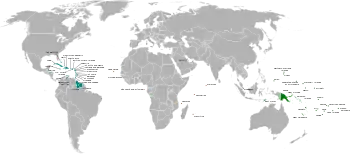Small Island Developing States
Small Island Developing States (SIDS) are low-lying coastal countries. They share similar problems because of their size. Some of these problems are: small but growing populations, limited resources, and long distances from other countries.

The SIDS were first seen as a distinct group of developing countries at the United Nations Conference on Environment and Development in June 1992. The Barbados Programme of Action was made in 1994 to help the SIDS to develop.
List of SIDS
Currently, the United Nations Department of Economic and Social Affairs lists 44 small island developing states.[1] These are broken down into three geographic regions: the Caribbean; the Pacific; and Africa, Indian Ocean, Mediterranean and South China Sea (AIMS). Each of these regions has a regional organisation for cooperation: the Caribbean Community, the Pacific Islands Forum and the Indian Ocean Commission.
- Caribbean
 Anguilla
Anguilla Antigua and Barbuda
Antigua and Barbuda Aruba
Aruba Bahamas
Bahamas Barbados
Barbados British Virgin Islands
British Virgin Islands Dominica
Dominica Grenada
Grenada Montserrat
Montserrat.svg.png.webp) Netherlands Antilles
Netherlands Antilles Puerto Rico
Puerto Rico Saint Kitts and Nevis
Saint Kitts and Nevis Saint Lucia
Saint Lucia Saint Vincent and the Grenadines
Saint Vincent and the Grenadines Trinidad and Tobago
Trinidad and Tobago United States Virgin Islands
United States Virgin Islands
- Pacific
 American Samoa
American Samoa Cook Islands
Cook Islands Fiji
Fiji French Polynesia
French Polynesia Guam
Guam Kiribati
Kiribati Marshall Islands
Marshall Islands Micronesia
Micronesia Nauru
Nauru New Caledonia
New Caledonia Niue
Niue Northern Mariana Islands
Northern Mariana Islands Palau
Palau Samoa
Samoa Solomon Islands
Solomon Islands Tonga
Tonga Tuvalu
Tuvalu Vanuatu
Vanuatu
- Africa Indian Ocean Mediterranean South China Sea (AIMS)
References
- List of SIDS United Nations, Office of the High Representative for the Least Developed Countries, Landlocked Developing Countries and Small Island Developing States
Other websites
- About SIDS, United Nations Office of the High Representative for the Least Developed Countries, Landlocked Developing Countries and Small Island Developing States Archived 2013-01-31 at the Wayback Machine
- AOSIS Members, Alliance of Small Island States Archived 2008-09-24 at the Wayback Machine
- SIDS Network Small Islands Development States Network Archived 2013-02-14 at the Wayback Machine